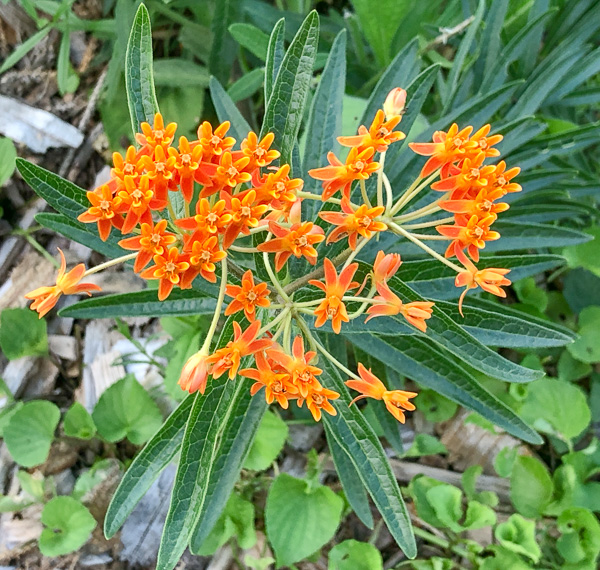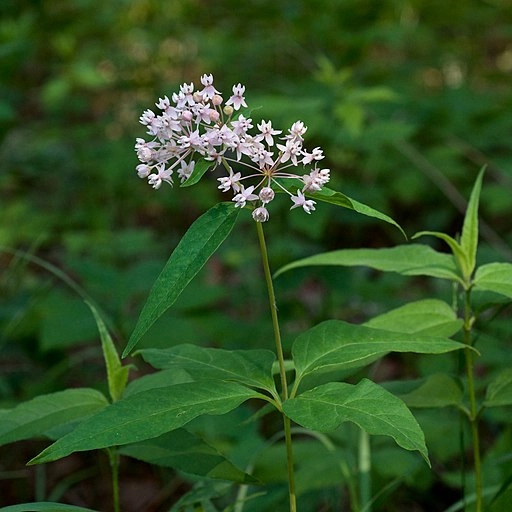Native Milkweeds (Asclepias spp.) that can be grown in Western Pennsylvania Gardens

Milkweeds (Asclepias spp.) are popular choices for butterfly gardens because of their association with the Monarch butterfly (Danaus plexippus). However, these plants also host other species of butterflies including the Queen (Danaus gilippus), Gray Hairstreak (Strymon melinus), Viceroy (Limenitis archippus) and several moths such as the very unexpected cycnia (Cycnia inopinatus) and others in the United States. Around the world, this genus also hosts the African Queen butterfly (Danaus chrysippus), several grasshoppers/locusts in Africa and the Isabella’s Longwing (Eueides isabella) in Central and South America.
In Pennsylvania, we have seven native species of milkweed:
Common Milkweed (Asclepias syriaca)
Common milkweed, as the name would imply, is one of the most common milkweed species. Often growing in open areas such as fields and roadsides, this plant grows up to 6 feet tall and has pink to white flowers that bloom from June to August. The flowers when blooming have a sweet and pleasant fragrance that can be enjoyed throughout the garden. The species name, syriaca, is Latin for the country of Syria and was so named because Linnaeus mistakenly thought this plant came from Syria. Common milkweed prefers places that have full sun to part shade and well-drained soil and is hardy in zones 3 to 9. It can spread by rhizomes in the garden and has a tendency to pop-up wherever it wants to, so it needs some space. These plants not only host the Monarch butterfly, but also milkweed beetles and bugs that are orange and black colored. This species is native throughout western Pennsylvania.


Butterfly Weed (Asclepias tuberosa)
Butterfly weed is one of the most common milkweeds to be found in gardens. The flowers are generally orange but can range to yellow and they bloom from June to September. The plants, which can grow from 1 to 3 feet tall, prefer places that full sun to part shade and well-drained soil and is hardy in zones 3 to 9. The species name, tuberosa, derives from the deep taproot that the plant develops. There are three subspecies, of which two, subsp. interior and subsp. tuberosa, occur in western Pennsylvania. Unlike the other species of milkweeds (Asclepias spp.), this species does not have milky sap in the leaves or stem. Likely because of the deep taproot, butterfly weed does not spread much in the garden and therefore makes a good neighbor to other plants.


Swamp Milkweed (Asclepias incarnata)
Swamp milkweed, as the common name would suggest, likes places that are moist such as shores of streams, lakes, and ponds. In Pennsylvania there are two subspecies present, incarnata and pulchra, but we only have subsp. incarnata in western Pennsylvania, which grows throughout. In a garden it can tolerate most soils whether they are moist or not. Growing from 3 to 5 feet tall, the white, red to purple flowers bloom from July to September and is hardy in zones 3 to 9. This plant enjoys places with full sun to partial shade having moist to mesic and well-drained soils.
Purple Milkweed (Asclepias purpurascens)
Purple milkweed is so called because of the purple flowers, which are the origin of the species name, purpurascens, meaning purple in Latin. The flowers can range to pink in color and bloom from May to July. The plants grow from 2 to 6 feet tall and prefers places that have full sun to part-shade in moist soil that is well-drained. Purple milkweed is found in the southwestern part of western Pennsylvania and is hardy in zones 3 to 8.


Four-leaf Milkweed (Asclepias quadrifolia)
Four-leaf milkweed is so called because of the four-leaved whorls on the stem and is the origin of the species name, quadrifolia. Growing from 1 to 3 feet tall, it has white to pink flowers that bloom from April to July and is hardy in zones 5 to 8. Four-leaf milkweed prefers places that have full sun to part shade and dry rocky soils. Because of its soil preference, this species may be best suited to a rock garden. This species is found throughout western Pennsylvania.


